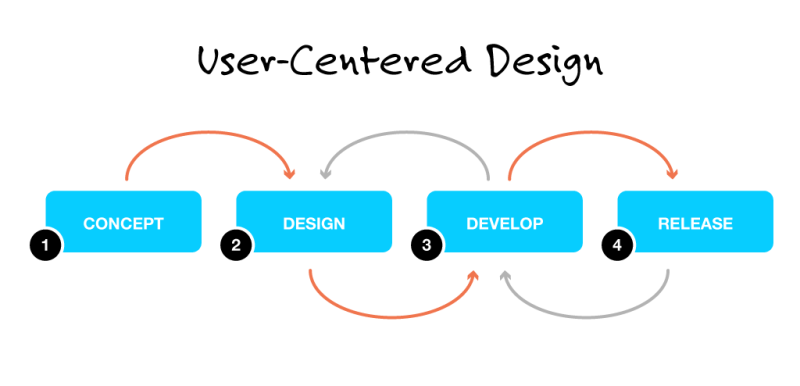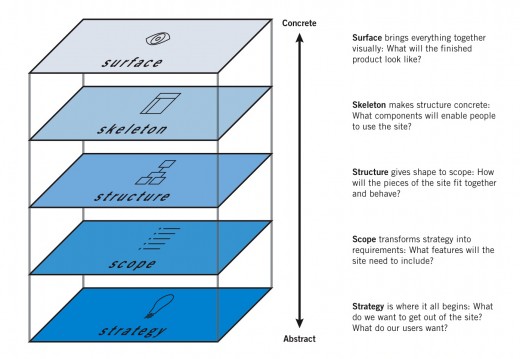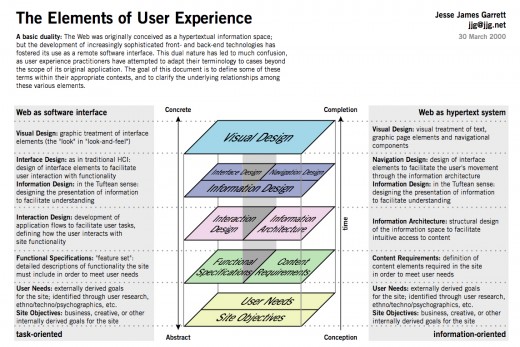WEB202 » The Elements of the User Experience
User Experience is not about how a product is designed to work on the inside, but rather about how it works on the outside where a person comes into contact with the product and needs to actually use the product. How a product actually works can often and should be the difference between a successful product and one that fails.
See Also:
- Subject to Change: The Experience Is the Product | Adaptive Path
- What Is User Experience Design? Overview, Tools And Resources | Smashing Magazine
- User Experience Deliverables | Semantic Studios
User Experience and the Web
In virtually every case, websites are a “self-service” product.
A user is left to figure out how the web site they have come to works and how they can navigate through to find what they are looking for.
As the race to be first out there on the web to grab the initial market share came and went, the competing companies came to find out that having more features on their web sites didn’t necessarily mean that their sites were useful, easy to navigate, nor easy to use.
See Also: How a Visible Workflow Achieves Web Usability | Mike Sinkula
Users became frustrated and did not want to go back to those sites which in turn meant a loss of market share for those companies. So, It is now plausible to say that it is the “user experience” determines whether your customer will ever come back to your site or not.
Competitive Advantage
It is not enough to just put your content out there on the web just to put it out there—content needs to be presented in a way that people will understand it.
- If your site was difficult to work with, then your company as a whole must be difficult to work with as well.
- If the experience was bad enough, they just won’t ever come back.
Return on Investment (ROI)
Return on Investment (ROI) is usually, in the business world, measured in terms of money—for every dollar I spend, how many dollars am I getting back?
- Improving the efficiency of your site’s tools and helping people work faster and make fewer mistakes will increase the productivity of the business as a whole.
- On the web, ROI can be measured in terms of “conversion rate” or by converting incoming customers to the next level of building a relationship with your company. Getting the user to come back is way of achieving your web site’s business goal.
- A quality user experience can translate into “converting” casual browsers into active buyers.
- A typical example of a poor “conversion” is the abandoned shopping cart—where the user attempts to buy a product, but finds the shopping cart experience too difficult to the point where they leave without making the final purchase.
User-Centered Design
The practice of creating engaging, efficient user experiences is called User-Centered Design—taking the user experience into account as you develop your product.
- Everything that the user experiences should be a conscious decision on the part of the designer of the site.
- If you do not provide your user with a positive experience, they will not use your site.
- Without users, your site is nothing more than a waste of server space.
- For the users who do come to your site, you must set out to provide them with an experience that is coherent, intuitive and pleasant.
The Elements of the User Experience
The experience that you will be creating for the user should be a result of a well planned set of decisions that will serve the purpose of making your site a success for you and your user. The decisions you will make on designing a coherent, intuitive and pleasant experience for the user will be based one (plane) upon the other in a strategic and hierarchical method:
- The Surface Plane: On the surface you see a series of web pages made up of images and text that will tell you where you are, where you can go and what is here.
- The Skeleton Plane: Beneath the surface is the skeleton of the site – the layout and placement of where those buttons, images and text are to be for maximum effect and efficiency of your site.
- The Structure Plane: The structure of your site is a more concrete expression of the skeleton of your site – defining hoe the user got to the page they are on and where else they could go. The skeleton might define the arrangement of the navigation while the structure would define what those categories actually were.
- The Scope Plane: As the structure defines the way in which the various features and functions of the site fit together, the scope defines what the purpose behind those features and functions are.
- The Strategy Plane: The scope of your website is fundamentally determined by the strategy of your site – what the company is trying to gain from the website and what they want the users to leave their site with.
The five planes of the User Experience provide the conceptual framework for talking about the user experience problems and the tools (assignments) we will use to solve them:
This portion of the Premium Design Works website is written by Mike Sinkula for the Web Design & Development students at Seattle Central College and the Human Centered Design & Engineering students at the University of Washington.















6 Comments:
I haven’t had a chance to sift through the methodology of the Baymard Institute, but this could be an interesting resource for e-commerce data: http://baymard.com/checkout-usability/benchmark/top-100
They say a picture is worth a thousand words….
http://c0022891.cdn1.cloudfiles.rackspacecloud.com/en/wp-content/uploads/2006/02/3663684287_15f68a8b3e_o.gif
two years later and still coming to this page – Thanks Mike.
Now what’d you learn at UW HCI school? :) huh, huh?
Great Fireworks Prototyping Tutorials
http://speckyboy.com/2011/11/07/wireframing-prototyping-with-adobe-fireworks-resources-and-tutorials/
Trackbacks:
[…] http://www.peterme.com/2012/05/04/user-experience-is-strategy-not-design/ http://www.sccc.premiumdw.com/web202/the-user-experience/ http://uxdesign.com/ux-defined https://uxthink.wordpress.com/page/5/ […]
[…] (Source :http://www.sccc.premiumdw.com/web202/the-user-experience/) […]